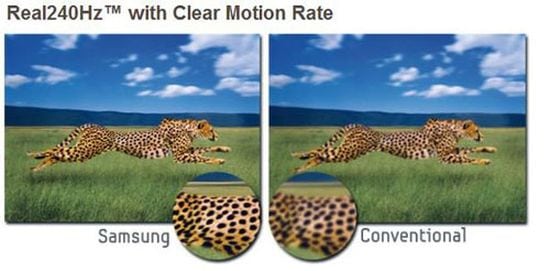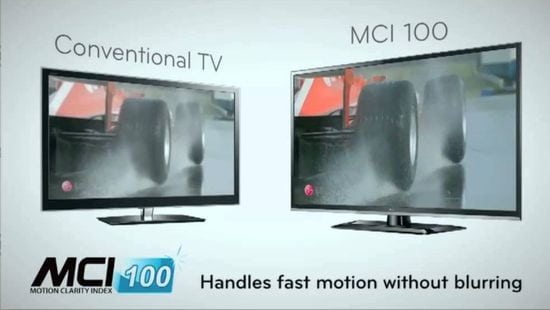The matrix frequency is measured in hertz. In a highly competitive environment, companies often try to use it for marketing purposes. However, a real increase in frequency is technically difficult and requires significant costs. Therefore, its value is often artificially overstated due to incorrect interpretation of additional factors. Even advertising on the Internet often contains the values of Motion Rate or Motion Flow or Motion Clarities, increasing its uncertainty.
The matrix frequency characterizes the rate updates of the LCD panel. A TV panel with a steep front of the clock pulse transmits the dynamic image more clearly. Abrupt change of frames on the more slow panel causes the flicker.
Today interpolation frame is a most efficient way to solve this problem. This technology works as follows. TV with refresh rate of 100 Hz calculates and adds the intermediate frame that is based on two contiguous frames with frequency 50 Hz. This technology provides a smoother playback of moving image.
Disconnection of the backlight also reduces the blurring when changing frames. So-called Scanning Backlight also provides the same effect. Other methods of image optimization, e.g., with the help of a local dimming or a dynamic backlight improves the contrast, but do not increase the clarity and smoothness. Therefore, increasing the matrix frequency is the most effective method for improving the playback quality of highly dynamic scenes.
Interpretation of refresh rate by the companies
Samsung widely uses the CMR (Clear Motion Rate) parameter. The company said that the refresh rate is not enough capacious for description of this TV feature. According to the company experts, CMR is the best option. But CMR includes the characteristics of backlight and CPU. As a result, LCD panel with a frame rate of 100 Hz is conditionally transformed into a ultrafast screen with 400Hz CMR. But this TV actually plays only 100 fps (frames per second). Samsung just multiplies digits: 100 Hz (screen update) x 2 (interpolation frames) x 2 (flashing backlight) = 400 Hz CMR. Of course, this technology improves the playback quality, but not due to a real increase in the matrix frequency.
Advertising the LG Electronics focuses attention on the MCI value. In fact, the MCI (Motion Clarity Index) parameter includes a combination of refresh rate, the scanning backlight, local dimming and interpolation frames.
The MXR (Motionflow XR) parameter in Sony models similarly combines refresh rate, interpolation frames and a scanning backlight. The same combination in Toshiba is called the AMR (Active Motion Rate).
Philips uses a PMR (Perfect Motion Rate) index, the calculation of which additionally takes into account various methods of image optimization. PMR parameter adds scanning and flickering the backlight, local dimming, amplification of backlight for very bright frames and the weakening for dark frames as multipliers for the refresh rate. As a result, the TV with a refresh rate of 200 Hz receives an unprecedented value 1200Hz PMR. A similar situation exists for plasma TVs.
Conclusion
The TV will show a maximum of 100 fps (frames per second) if the matrix is designed for 100 Hz. Today, the most rapid matrices provides a frequency of 200 fps (200 Hz).
Comparison of CMR, MCI, MXR and PMR indexes is incorrect, because they are calculated using different algorithms. Therefore, the use of this criterion when choosing a TV requires additional data.
This video demonstrates the work of Motionflow 200 Hz technology, which was developed by SONY and is now used in the BRAVIA TVs.



